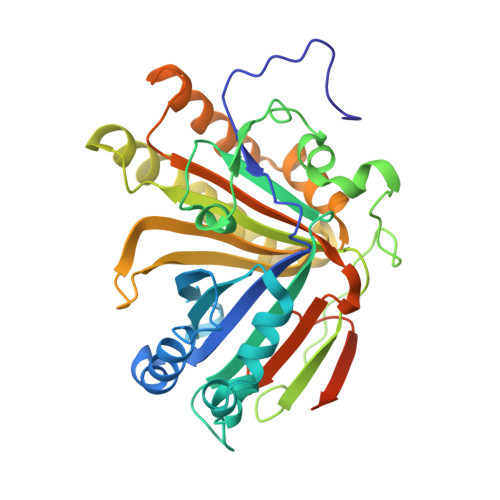Crystal structural analysis of aldoxime dehydratase from Bacillus sp. OxB-1: Importance of surface residues in optimization for crystallization.
Matsui, D., Muraki, N., Chen, K., Mori, T., Ingram, A.A., Oike, K., Groger, H., Aono, S., Asano, Y.(2022) J Inorg Biochem 230: 111770-111770
- PubMed: 35272237
- DOI: https://doi.org/10.1016/j.jinorgbio.2022.111770
- Primary Citation of Related Structures:
7F2Y, 7F2Z, 7F30 - PubMed Abstract:
Aldoxime dehydratase (Oxd) is a heme enzyme that catalyzes aldoxime dehydration to the corresponding nitriles. Unlike many other heme enzymes, Oxd has a unique feature that the substrate binds directly to the heme. Therefore, it is thought that structural differences around the bound heme directly relate to differences in substrate selection. However sufficient structural information to discuss the substrate specificity has not been obtained. Oxd from Bacillus sp. OxB-1 (OxdB) shows unique substrate specificity and enantioselectivity compared to the Oxds whose crystal structures have already been reported. Here, we report the crystal structure of OxdB, which has not been reported previously. Although the crystallization of OxdB has been difficult, by adding a site-specific mutation to Glu85 located on the surface of the protein, we succeeded in crystallizing OxdB without reducing the enzyme activity. The catalytic triad essential for Oxd activity were structurally conserved in OxdB. In addition, the crystal structure of the Michaelis complex of OxdB and the diastereomerically pure substrate Z-2-(3-bromophenyl)-propanal oxime implied the importance of several hydrophobic residues for substrate specificity. Mutational analysis implicated Ala12 and Ala14 in the E/Z selectivity of bulky compounds. The N-terminal region of OxdB was shown to be shorter than those of Oxds from Pseudomonas chlororaphis and Rhodococcus sp. N-771, and have high flexibility. These structural differences possibly result in distinct preferences for aldoxime substrates based on factors such as substrate size.
- Department of Biotechnology, Toyama Prefectural University, 5180 Kurokawa, Imizu, Toyama 939-0398, Japan; Department of Biotechnology, College of Life Sciences, Ritsumeikan University, 1-1-1 Noji-higashi, Kusatsu, Shiga 525-8577, Japan.
Organizational Affiliation:

















